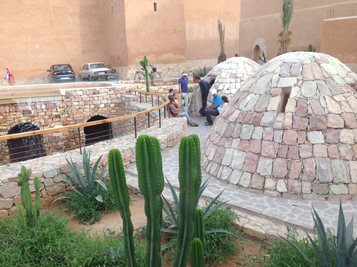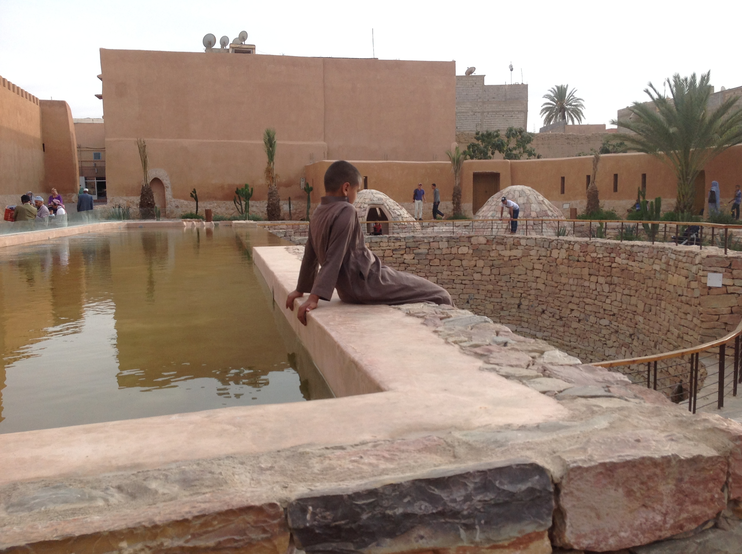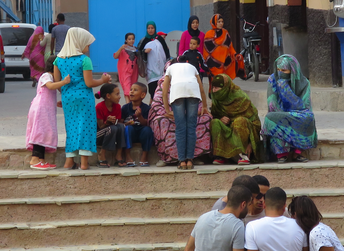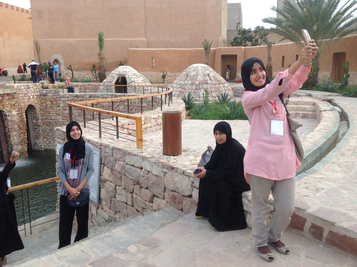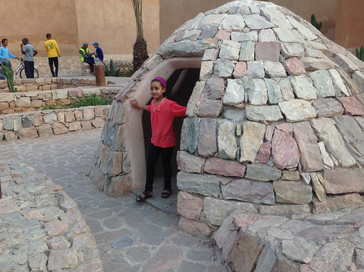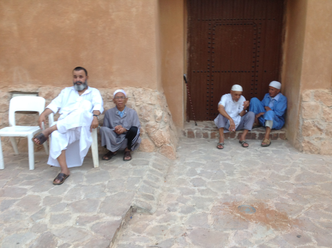Aïn Zerka: A Senso-Social Description of Space
La Source Bleue is the colonial appellation designed to help promote Tiznit as a tourist destination. Located at the ancient heart of the city, its Arabic name Aïn Aqdim means “the ancient source.” For the inhabitants, it is "the initial source, i.e. the source from which everything has begun, symbolizing the foundation of Tiznit" (Naji and Goeury 2020: 8, translated by the author). The discovery of the spring is connected to the myth of Lalla Zninia: a woman, accompanied by her dog, who settled nearby. Buried in the adjacent mosque, her presence ensures the sacredness of the place.[3]
In a recent ambition to make the history of the city comprehensible, the municipality of Tiznit launched a vast project to rehabilitate the ancient city. The project included several spaces and buildings, and among them the Source Bleue was at the center of interest (Naji 2013). Conceived as the site in which a tangible and intangible heritage intersects, the Source Bleue has become a place where memories of collective founding institutions (Goeury 2018) are superimposed onto the memories of female fertility rituals (Naji, Goeury and Boumzgou 2016). In 2015, Naji responds to this by proposing a new staging of the spring, surrounded by a small public garden (Fig. 2). Naji attempts to recall the history through evincing it in the atmosphere of the oasis, with water flow and birdsong (Naji and Goeury 2020).
The Aïn Zerka is a small, intimate space, enclosed by dwellings to the west and south. It is covered entirely with stone: the basin, the arches of the waterfall, the floor covering, the alley that runs along it, and the khettarates (an underground draining gallery leading the water to the oasis gardens). The stone reflects the reality of an arid climate. Yet, the water, placed at the center, softens and refreshes the whole. The basin, constructed during the colonial period, has been recently redesigned: a reflecting pool, elevated by a pump, allows for a water cascade and a new circulation of water. This cascade falls into the basin, while a small diversion flows into a tiny, shallow channel running through the garden. The khettarates consists of two stone domes containing two spiral staircases leading to a water gallery. This space is used for educational purposes.
The architectural composition plays with various levels: the steps of the amphitheater; the reflecting pool, raised one meter above street level; the khettarates, with stairs descending to the water level in the basin; a few steps raising the garden above street level. These steps, levels, and curbs ensure a variety of listening situations.
The space is welcoming for all ages: young mothers, elderly people, children and teenagers. Women, more numerous than men, sit on the steps, wrapped in their mellafahs, colorful Saharan outfits that catch the eye in counterpoint to the architectural ensemble dominated by the ocher of the stones.
Raised some steps above the street, the back garden is protected from street traffic, which is an element that attracts the presence of children. They appropriate the architectural elements through multiple gestures: tactile contact with the water, climbing the khettarates, jumping on the steps, and, most noticeably, screaming to experience the reverberation of the space. In brief, this space constitutes a playground with multiple possibilities for the children (Breviglieri and Landoulsi 2016).
For adults, the space encourages taking a break or socializing. Several architectural elements make this possible: the surrounding walls of the dwelling – slightly inclined – invite users to sit and talk while monitoring their children; the stairs are frequently sat upon; the porches of the houses favor social meetings. This is not only a preferred place for the inhabitants, it also invites people arriving from further destinations. Individuals also find their place: sitting on the walls, which mark the site’s entrance, they enjoy a certain contemplative intimacy. As for young people, they often stand a few minutes in front of the stairs, take selfies, and then leave.
The Kasbah Aghenaj, at the opposite side of the spring, is an enclosed space surrounded by the earth walls of a fortification. Initially a barracks, then a civil prison, it is now an urban space open to the public. It can be accessed by a door raised a few steps from street level. Interestingly, this slight elevation offers a panoramic listening experience. With the exception of a single tree, the space of the Kasbah is made of stone and designed as a theater, with multiple steps around a podium that is used for ceremonies (Fig. 3).

